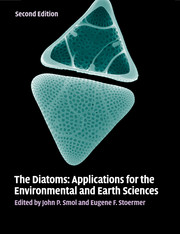Book contents
- Frontmatter
- Contents
- List of contributors
- Preface
- Part I Introduction
- Part II Diatoms as indicators of environmental change in flowing waters and lakes
- Part III Diatoms as indicators in Arctic, Antarctic, and alpine lacustrine environments
- Part IV Diatoms as indicators in marine and estuarine environments
- 15 Diatoms and environmental change in large brackish-water ecosystems
- 16 Applied diatom studies in estuaries and shallow coastal environments
- 17 Estuarine paleoenvironmental reconstructions using diatoms
- 18 Diatoms on coral reefs and in tropical marine lakes
- 19 Diatoms as indicators of former sea levels, earthquakes, tsunamis, and hurricanes
- 20 Marine diatoms as indicators of modern changes in oceanographic conditions
- 21 Holocene marine diatom records of environmental change
- 22 Diatoms as indicators of paleoceanographic events
- 23 Reconsidering the meaning of biogenic silica accumulation rates in the glacial Southern Ocean
- Part V Other applications
- Part VI Conclusions
- Glossary, acronyms, and abbreviations
- Index
- References
20 - Marine diatoms as indicators of modern changes in oceanographic conditions
from Part IV - Diatoms as indicators in marine and estuarine environments
Published online by Cambridge University Press: 05 June 2012
- Frontmatter
- Contents
- List of contributors
- Preface
- Part I Introduction
- Part II Diatoms as indicators of environmental change in flowing waters and lakes
- Part III Diatoms as indicators in Arctic, Antarctic, and alpine lacustrine environments
- Part IV Diatoms as indicators in marine and estuarine environments
- 15 Diatoms and environmental change in large brackish-water ecosystems
- 16 Applied diatom studies in estuaries and shallow coastal environments
- 17 Estuarine paleoenvironmental reconstructions using diatoms
- 18 Diatoms on coral reefs and in tropical marine lakes
- 19 Diatoms as indicators of former sea levels, earthquakes, tsunamis, and hurricanes
- 20 Marine diatoms as indicators of modern changes in oceanographic conditions
- 21 Holocene marine diatom records of environmental change
- 22 Diatoms as indicators of paleoceanographic events
- 23 Reconsidering the meaning of biogenic silica accumulation rates in the glacial Southern Ocean
- Part V Other applications
- Part VI Conclusions
- Glossary, acronyms, and abbreviations
- Index
- References
Summary
Marine diatoms as indicators of modern environment change
A substantial part of the ocean's primary productivity is provided by diatoms (Tréguer et al., 1995). In general, they are the dominant primary producers in temperate and cold areas, and are very abundant in the recently upwelled waters of Eastern Boundary Currents and in diverging surface currents where nutrients are brought to the surface (Nelson et al., 1995, and references therein). On an annual basis, the relative contribution of diatoms to primary productivity is highly variable: Nelson et al. (1995) and Tréguer et al. (1995) proposed upper limits of 35% in oligotrophic areas and up to 75% in coastal upwelling areas and other nutrient-rich systems. Regardless of the area, the general trend is for an increase in the relative abundance of diatoms in the phytoplankton together with primary productivity (Ragueneau et al., 2000). As a general statement we may say that diatoms are the dominant primary producers in a number of oceanographic settings that offer both the required high-nutrient and turbulence conditions (e.g. coastal upwelling areas, equatorial divergences, ice-edges, river plumes; Ragueneau et al., 2000). In contrast, small, non-siliceous pico- and nanoplankton are of great importance to total productivity in oligotrophic regions (Tréguer et al., 1995, and references therein).
- Type
- Chapter
- Information
- The DiatomsApplications for the Environmental and Earth Sciences, pp. 373 - 400Publisher: Cambridge University PressPrint publication year: 2010
References
- 18
- Cited by



